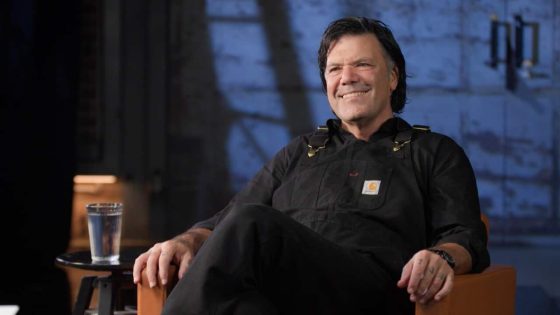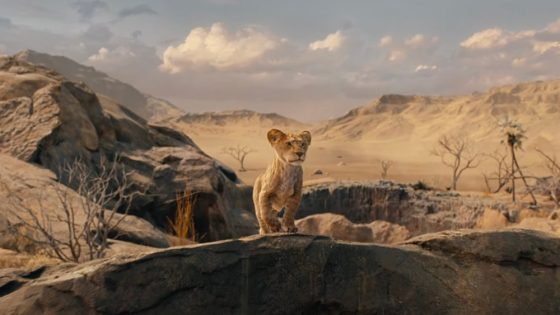As the waters of the devastating Lismore floods slowly retreated in early March 2022, renowned Dhungutti painter Blak Douglas was struck by the images of mob struggling to restart their lives.
Feeling compelled to help in any way he could, the artist loaded his ute full of donated supplies and drove north to the Koori Mail’s donation collection point.
The devastation he encountered left a mark.
“It was gobsmacking to see water level marks on buildings 14 metres high. It’s something astonishing,” he told Living Black host Karla Grant.
In the weeks that followed, Blak Douglas contacted his friend, Wiradjuri artist and Lismore local Karla Dickens, and painted the now famous portrait of her standing with a steely gaze of quiet fury amidst the apocalyptic floodwaters of her hometown.
Wiradjuri woman Karla Dickens standing in the devastating flood waters in Lismore. Source: Supplied / Supplied: AGNSW, copyright Blak Douglas
To his shock, Douglas would win the prestigious Archibald Prize competition for his piece, titled ‘Moby Dickens’.
“I’m still pinching myself today,” he said of the win, which comes with $100,000 dollars.
“I honestly never thought that a politicised portrait, with such weight, would win that prize.”
Finding the artist within
Growing up in ‘mono-cultural’ Western Sydney was a jarring experience for the young Dunghutti boy. Source: Supplied / Blak Douglas
Before achieving that national acclaim as an artist, ‘Blak Douglas’ didn’t carry that moniker; he went by his birth name name Adam Hill.
Raised by a Dhungutti father and his Irish-descent mother, he grew up in the suburbs of Western Sydney, near Blacktown.
This was the 1980s, a time when Dame Edna ruled the television set, Paul Hogan offered to ‘put a shrimp on the barbie’ for you, and Australia revelled in nationalist spirit as it celebrated its bicentennial.
But it was during this time that, perhaps unsurprisingly, Hill simply felt like he didn’t belong.
“Growing up in a mono-cultured community in Western Sydney was a pretty odd experience.
“We had a really diverse neighbourhood, but there weren’t many Black faces around from our people.
“It was very hard thing to stand proud on behalf of your ancestry while being continually shot down for doing so.”
Blak Douglas’ Dunghutti heritage through his father was rarely discussed. Source: Supplied / Blak Douglas
Surrounded by his mother’s Irish family, he felt his father’s heritage was something to be kept secret.
“You didn’t bring up Aboriginal culture. It was coming out of that sensitive era where you just don’t go there.”
This disconnect from heritage had been passed down through many generations; Adam’s own father lost his mother when he was only nine years old.
He was then sent away to live with the white side of his family, saved from being institutionalised, but severed from his culture.
“[Dad] never spoke of our people. It was that era where you didn’t speak out if you didn’t have to, or it was uncomfortable to speak out.”
Finding culture
After finishing high school, Hill enrolled in graphic design and illustration at the University of Western Sydney.
He says it was the first time he felt accepted.
“Finding the solace and the egalitarian thinking of university in my own town was just like the pot of gold at the end of the rainbow.
“I didn’t realise that you could have such open-minded thinking people, as opposed to continually being chastised for your racial background.”
A young Blak Douglas with his father. Source: Supplied / Blak Douglas
It was at university that he met Aunty Jean South, who worked in the Aboriginal unit. She would go onto mentor him and encouraged him to explore his Aboriginal ancestry.
“Aunty Jean South said to me, ‘So your mum’s white, and your dad’s Black and you’ve been raised in this mono-cultured neighbourhood with this ideology.
“‘You are at a fork in a road, you can choose which way you want to go down.’ It was that moment that I felt the fire ignite in my belly.”
He began to trace his family’s roots back to Kempsey, his grandmother’s town.
Through a cousin, he managed to meet the extended members of his family, who welcomed him home with a big party. It would lead to more discoveries about his own identity.
Becoming ‘Blak’
Blak Douglas playing the didgeridoo at first art exhibition titled ‘Growing up on Dharug Country’ Source: Supplied / Blak Douglas
As he began to learn more about his Dhungutti culture, the young artist felt consistently stuck between two worlds.
Though art began to reflect more of his culture, he found himself once again struggling with his identity.
“I was going through a lot of experiences of identity crises. I was finding that as the more I started to get a name and get a platform, not only was I fending off attacks from white people saying, ‘You’re not Black enough’, I was also hearing [the same] from Blackfellas.
“And I thought, ‘Well, f**k ’em. I’m gonna play with this.'”
In creating his new name, he decided on ‘Blak,’ to stand for his people, and ‘Douglas’, a dominant Highland name, for his Irish heritage.
‘Blak Douglas’ was born, and he’s remained ever since.
Taking on the Commonwealth
As Douglas’ body of work grew over the years, so too has his passion to tell the forgotten stories of his family and his people.
So it was that through a chance encounter with a long-lost cousin the artist would find his latest passion project in Kempsey.
“We had a barbecue thrown for us at this little community hall and the mob unrolled this family tree.
“It was about six foot long, and they had all the Dhungutti mobs, and there was this completely vacant family patch, and that was us.
“That’s a tremendously proud moment for any mob who are looking for where they came from.”
Struck by the importance of the moment, Douglas made the decision to film a self-funded documentary that followed his journey to uncover his family’s history.
Tied to the story was the 2017 Third National Indigenous Triennial at the National Gallery of Australia, where Douglas was an exhibiting artist.
“And what better way to make an impact in that exhibition, than to produce for the first time, the portrait of my grandmother that we never knew about.
“That’s what this documentary is about.”
The project titled ‘Blak Douglas vs the Commonwealth’, made its public debut in March this year and was met with positive reviews. For Douglas, he hopes that by demonstrating through his art throughout the film that it encourages youth to look further into their family history and make a difference.
“We can’t keep denying those kids that opportunity to [find themselves]; at least for your own knowledge, you’ve gotta find out where your people are.”
Watch Living Black weekly on Mondays at 8.30pm on NITV, and on SBS, Tuesdays at 10.30pm.
Living Black will also be available to stream for free on SBS On Demand and will be subtitled in Arabic, Simplified Chinese, Traditional Chinese, Korean and Vietnamese.







